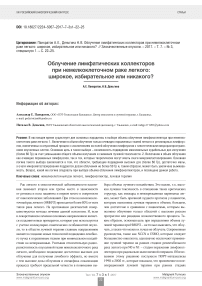Облучение лимфатических коллекторов при немелкоклеточном раке легкого: широкое, избирательное или никакого?
Автор: Панкратов А.Е., Деньгина Н.В.
Журнал: Злокачественные опухоли @malignanttumors
Статья в выпуске: 3S, 2017 года.
Бесплатный доступ
В настоящее время существует две основных парадигмы в выборе объема облучения лимфоколлектора при немелкоклеточном раке легкого: 1. Включение в объем облучения только очевидно пораженных тканей легкого и регионарных лимфоузлов, вовлеченных в опухолевый процесс с исключением из полей облучения лимфоузлов с гипотетическим микрораспространением опухолевых клеток. Основная цель в таком выборе - возможность подведения максимальных курабельных доз излучения (более 60 Гр) за счет уменьшения общего объема излучения и снижения лучевой токсичности. 2. Включение в объем облучения как очевидно пораженных лимфоузлов, так и тех, которые теоретически могут иметь очаги микрометастазирования. Основная логика такого выбора заключается в том, что области, требующие подведения высоких доз (более 60 Гр), достаточно малы, а очаги микрометастазирования поддаются дозам облучения не более 50 Гр и, таким образом, может быть увеличена выживаемость. Вопрос, какой же логике следовать при выборе объема облучения лимфоколлекторов, и посвящена данная работа.
Немелкоклеточный рак легкого, лимфоколлектор, лучевая терапия
Короткий адрес: https://sciup.org/140223273
IDR: 140223273 | DOI: 10.18027/2224-5057-2017-7-3s1-22-25
Список литературы Облучение лимфатических коллекторов при немелкоклеточном раке легкого: широкое, избирательное или никакого?
- PORT Meta-analysis Trialists Group. Postoperative radiotherapy in non-small-cell lung cancer: Systematic review and meta-analysis of individual patient data from nine randomised controlled trials. Lancet. 1998; 352: 257-63.
- PORT Meta-analysis Trialists Group. Postoperative radiotherapy for non-small-cell lung cancer. Lang. Cancer. 2005; 47: 81 -3.
- Abuodeh YA, Naghavi A. O., DeMarco M, Tonner B, Feygelman V, Stevens CW, Perez BA, Dilling TJ Quantitatively Excessive Normal Tissue Toxicity and Poor Target Coverage in the PORT Meta-Analysis (MA): A Dosimetric Study. Int JRadiat Oncol Biol Phys 2016;96:442.
- Douillard JY, Rosell R, De Lena M, et al. Impact of postoperative radiation therapy on survival in patients with complete resection and stage I, II, or IIIA non-small-cell lung cancer treated with adjuvant chemotherapy: the adjuvant Navelbine International Trialist Association (ANITA) Randomized Trial. Int JRadiat Oncol Biol Phys 2008;72:695-701.
- Osarogiagbon, R. U., Lin, C. C., Smeltzer, M. P. et al, Prevalence, prognostic implications, and survival modulators of incompletely resected non-small cell lung cancer in the U. S. National Cancer Data Base. J Thorac Oncol. 2016;11: e5 -e16.
- Lally B. E., Detterbeck F. C., Geiger A. M., Thomas C. R. Jr, Machtay M., Miller A. A. et al. The risk of death from heart disease in patients with non-small cell lung Cancer whoreceive postoperative radiotherapy: analysis of the Surveillance, Epidemiology, and End Results database. Cancer. 2007; 110 (4): 911-7.
- Billiet C., Decaluwй H., Peeters S., Vansteenkiste J., Dooms C., Haustermans K. et al. Modern postoperative radiotherapy for stage III non-small cell lung cancer may improve local control and survival: A meta-analysis. Radiother. Oncol. 2013; 110 (1): 3-8.
- Emami B, Graham MV. Lung. In: Perez C, Brady LW, editors. Principles and practice of radiation oncology. New York: Lippincott-Raven; 1998. p. 1181-1220.
- Rosenzweig K et al. Elective nodal irradiation in the treatment of non-small-cell lung cancer with three-dimensional conformal radiation therapy. Int J Radiat Oncol Biol Phys. 2001 Jul 1;50 (3):681-5.
- Van LJ, De Ruysscher D, Wanders R, Boersma L, Simons J, Oellers M, Dingemans AM, Hochstenbag M, Bootsma G, Geraedts W, Pitz C, Teule J, Rhami A, Thimister W, Snoep G, Dehing-Oberije C, Lambin P: Selective nodal irradiation on basis of (18) FDG-PET scans in limited-disease small-cell lung cancer: a prospective study. Int J Radiat Oncol Biol Phys 2010, 77: 329-336.
- Martinez-Monge R, Fernandes PS, Gupta N, Gahbauer R: Cross-sectional nodal atlas: a tool for the definition of clinical target volumes in three-dimensional radiation therapy planning. Radiology 1999, 211: 815-828.
- Mountain CF, Dresler CM. Regional lymph node classification for lung cancer staging. Chest 1997;111:1718-1723.
- Giraud P, Antoine M, Larrouy A: Evaluation of microscopic tumor extension in non-small-cell lung cancer for three-dimensional conformal radiotherapy planning. Int J Radiat Oncol Biol Phys 48:1015-1024, 2000.
- Senan S, Chapet O, Lagerwaard FJ, Ten Haken RK: Defining target volumes for non-small cell lung carcinoma. Semin Radiat Oncol 2004, 14: 308-314. 10.1016/j. semradonc. 2004.07.004.
- van Sornsen de Koste JR, Lagerwaard FJ, Nijssen-Visser MRJ: Which margins are necessary for incorporating mediastinal nodal mobility in involved field radiotherapy for lung cancer? Int J Radiat Oncol Biol Phys 53:115-119, 2002.
- Giraud P: Influence of CT images visualization parameters for target volume delineation in lung cancer (abstr). Radiother Oncol 56:39, 2000 (suppl 1).
- International Commission on Radiation Units and Measurements: Prescribing, Recording, and reporting photon beam therapy. Bethesda, MD: ICRU Report 50, 1993.
- International Commission of Radiation Units, Measurements, report no. 62: Prescribing, recording and reporting photon beam therapy (supplement to ICRU Report 50). Bethesda, MD: ICRU, 1999.


